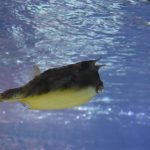
Recently, Zurich Zoo completed a reorganization of its aquarium exhibit (opened the 28th of September, 2016). The new exhibit features fewer but larger tanks compared with the original exhibit. There are now only eight aquariums: four are fresh water, three salt water, and one tank strikes a balance in between: brackish water.
This article is available also in: ![]() italiano
italiano
You may remember my previous article written some years ago, focusing on the Masoala reef aquarium, if you go to the Zurich Zoo, you can still admire it, since it is situated at another section of the zoo and therefore unaffected by the reorganization.
It would be impossible to describe to you all tanks in detail and therefore, we will not talk about the Piranha or the 30-year old Electric Eel. We won’t describe to you about the reef tank with the larger fishes (but we can show you a few photos, see below). In fact, we will focus on two aquariums, a very interesting shallow-water one and a beautiful reef aquarium of colossal dimensions filled with hard corals (in a separate article).
Our guided visit
Just in front of the Penguins we meet Sven Tschall, a young and pleasant man who is responsible for the aquarium exhibits. He shows us around for the next 1.5 hours, including the basement, where all the filters are placed. Sven isn’t only the aquarium curator but also the man who, more than anyone else, contributed most to the aquarium restructuring plan. He is really proud of the results of his work and shows his enthusiasm by describing to us every detail and also in promptly answering our questions and observations.

We could observe how engaged Zurich Zoo was concerning sustainability issues. For example, all freshwater fish stem from breeding farms and not from the wild (except for the electric eel that was already here before the reorganization). Furthermore, the tanks are isolated in order to reduce the heating and cooling activities and all corals they bought are frags taken from rearing tanks. Zoo Zurich have several suppliers based in Germany and Holland, but unfortunately it is not possible to breed every species of reef fish in captivity, and therefore saltwater fish are imported directly from the Indopacific Ocean.
We already saw the tanks from the tourist’s side, therefore we go directly to the backstage, were we can discover how the different aquariums are managed. Given the big amount of information we could get, I decided to write a separate review for the reef aquarium, and to do a more general presentation of the other aquariums in this article, but concentrating myself on the brackish water aquarium.
We are now looking at the tanks from above, the small one with Seahorses, the one with the bigger saltwater fishes like the Red lionfish (Pterois volitans), the Moorish idol (Zanclus cornutus) and the Bluespotted Ribbontail Ray (Taeniura lymma), in the same room we can see also the reef tank from above.
The control rooms are clean and modern, full of electronic controls to spot every possible malfunction in the system and avoid a potential fatal issue for the living creatures within the aquariums. The lights over the tanks are just a few centimeters above the surface of water, but can be lifted up, to enable a diver to enter the tank.

We then go down, to take a short look at the warehouse, which contains all the substances that are given to the aquariums, the spare parts and the filters. We also take a short look at the reverse osmosis system, where approximately 6 cubic meters of water (6’000 liters) are always present, for every need.
The filters for the freshwater tanks are placed in a big room and they work like the freshwater filters of our small tanks. Especially the mechanical part is very easy, with a single pipe taking the water from the aquariums and one pipe, with a single pump, bringing the water up, back in the tank. Every tank is separated from the others (except from two) and therefore every aquarium has its own water and filter system, yet the filter systems are always the same, to reduce complexity. Unfortunately we don’t have so much time, therefore we take a good look and then we go on.

A door isolates the saltwater filters, because salt is a threat for corrosion. In fact, in this room, everything possible is made of stainless steel, even the smallest screw, even if the price much higher than normal steel. Objects that were not available in stainless steel are highly corroded, like a sewer cover that we notice on the ground.
In this room we also see the filter for the aquarium of brackish water (continues on page 2).






















